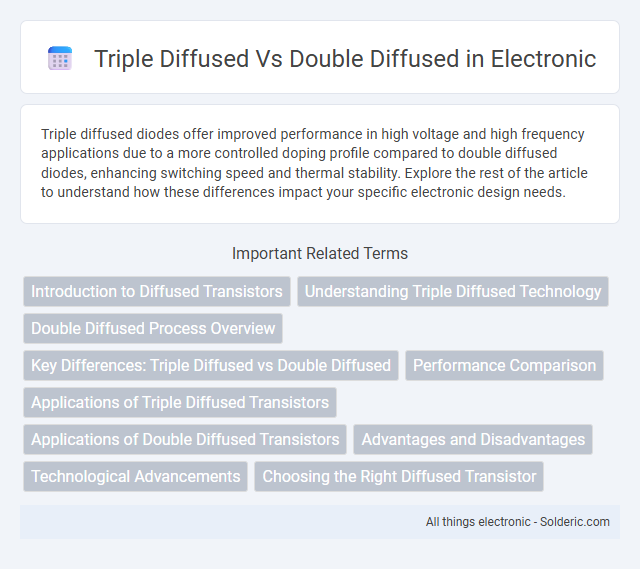Triple diffused diodes offer improved performance in high voltage and high frequency applications due to a more controlled doping profile compared to double diffused diodes, enhancing switching speed and thermal stability. Explore the rest of the article to understand how these differences impact your specific electronic design needs.
Comparison Table
| Feature | Triple Diffused | Double Diffused |
|---|---|---|
| Structure | Three-layer diffusion process | Two-layer diffusion process |
| Voltage Handling | Higher voltage capability | Moderate voltage capability |
| Current Rating | Higher current rating | Lower current rating |
| Switching Speed | Generally slower due to complex layers | Faster switching performance |
| Applications | High power devices, robust circuits | Standard power devices |
| Cost | Higher manufacturing cost | Lower manufacturing cost |
Introduction to Diffused Transistors
Diffused transistors utilize impurity diffusion to create regions within the semiconductor, with double diffused transistors featuring two successive diffusion steps for forming the base and emitter regions, enhancing device control and performance. Triple diffused transistors introduce an additional diffusion layer, improving parameters like breakdown voltage and gain by refining channel doping profiles and minimizing surface recombination. These diffusion techniques critically influence transistor characteristics such as switching speed, gain, and breakdown voltage, making them essential for designing high-performance semiconductor devices.
Understanding Triple Diffused Technology
Triple diffused technology enhances power MOSFETs by incorporating an additional diffusion layer compared to double diffused structures, resulting in improved breakdown voltage and reduced on-resistance. This extra diffusion layer refines the device's channel control and dopant distribution, optimizing electrical performance and reliability in high-voltage applications. Triple diffused devices exhibit superior switching speed and thermal stability, making them ideal for efficient power management and high-frequency circuits.
Double Diffused Process Overview
Double diffused process in semiconductor fabrication involves two sequential diffusion steps to create precise doping profiles, enhancing transistor performance and controlling threshold voltage. This method typically uses a shallow, high-concentration diffusion followed by a deeper, lighter diffusion to form the emitter and base regions. By contrast, triple diffused techniques add an extra diffusion step for even finer control of electrical characteristics, but the double diffused process remains widely used due to its balance of complexity and effective device optimization.
Key Differences: Triple Diffused vs Double Diffused
Triple diffused devices feature three layers of semiconductor material, enhancing voltage blocking capability and reducing leakage current compared to double diffused structures that have only two layers. This additional diffusion layer in triple diffused components improves ruggedness and switching performance, making them more suitable for high-power and high-frequency applications. Double diffused devices typically offer faster switching speeds but with lower voltage tolerance and higher leakage currents relative to triple diffused counterparts.
Performance Comparison
Triple diffused devices offer improved performance over double diffused ones by providing higher voltage handling and lower on-resistance, resulting in enhanced efficiency and faster switching speeds. The added diffusion layer in triple diffused structures reduces leakage currents and improves thermal stability, allowing Your circuits to operate reliably under higher stress conditions. This performance advantage makes triple diffused components ideal for high-power and high-frequency applications where durability and efficiency are critical.
Applications of Triple Diffused Transistors
Triple diffused transistors (TDTs) are predominantly utilized in high-power and high-frequency applications due to their enhanced current handling and thermal stability compared to double diffused transistors (DDTs). They are commonly found in power amplifiers, voltage regulators, and RF switching circuits where robust performance under elevated temperatures and stress is crucial. The triple diffusion process provides improved breakdown voltage and gain characteristics, making TDTs ideal for demanding automotive, industrial, and communication systems.
Applications of Double Diffused Transistors
Double diffused transistors are widely utilized in high-power and high-frequency applications, including power amplifiers, switching regulators, and audio amplifiers, due to their enhanced current-carrying capability and thermal stability. Their structure allows for improved gain and breakdown voltage characteristics, making them ideal for automotive electronics, industrial motor controls, and RF signal amplification. Compared to triple diffused transistors, double diffused variants offer easier manufacturing and cost-efficiency, satisfying performance demands in consumer and communication devices.
Advantages and Disadvantages
Triple diffused diodes offer higher voltage and power handling capabilities compared to double diffused diodes, making them ideal for high-performance applications. However, triple diffused diodes tend to have higher manufacturing complexity and cost, which can impact your project budget. Double diffused diodes provide better switching speeds and lower forward voltage drops, but they usually have lower voltage ratings and may not perform as well under high current stress.
Technological Advancements
Triple diffused technology enhances semiconductor performance through an additional diffusion step, resulting in improved threshold voltage control and reduced leakage current compared to double diffused designs. This advancement enables devices to achieve higher breakdown voltages and better thermal stability, making them ideal for high-power applications. Your circuits benefit from increased efficiency and reliability due to these refined fabrication techniques in triple diffused components.
Choosing the Right Diffused Transistor
Triple diffused transistors offer enhanced frequency response and higher current gain compared to double diffused transistors, making them ideal for high-performance applications requiring faster switching and better thermal stability. Double diffused transistors are suitable for general-purpose circuits where cost efficiency and moderate performance are prioritized, providing reliable operation in less demanding environments. When choosing the right diffused transistor, consider your specific needs for speed, gain, and thermal management to optimize your circuit's overall efficiency and longevity.
Triple diffused vs Double diffused Infographic

 solderic.com
solderic.com